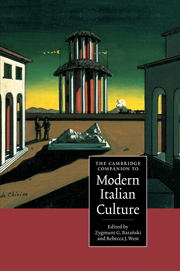Book contents
- Frontmatter
- Introducing modern Italian culture
- 1 The notion of Italy
- 2 Social and political cultures in Italy from 1860 to the present day
- 3 Questions of language
- 4 Intellectuals, culture and power in modern Italy
- 5 Catholicism
- 6 Socialism, Communism and other ‘isms’
- 7 Other voices: contesting the status quo
- 8 Narratives of self and society
- 9 Searching for new languages: modern Italian poetry
- 10 Drama: realism, identity and reality on stage
- 11 Italian cinema
- 12 Art in modern Italy: from the Macchiaioli to the Transavanguardia
- 13 A modern identity for a new nation: design in Italy since 1860
- 14 Fashion: narration and nation
- 15 The media
- 16 Since Verdi: Italian serious music 1860-1995
- 17 Folk music and popular song from the nineteenth century to the 1990s
- 18 Epilogue: Italian culture or multiculture in the new millennium?
- Index
- Series List
3 - Questions of language
Published online by Cambridge University Press: 28 May 2006
- Frontmatter
- Introducing modern Italian culture
- 1 The notion of Italy
- 2 Social and political cultures in Italy from 1860 to the present day
- 3 Questions of language
- 4 Intellectuals, culture and power in modern Italy
- 5 Catholicism
- 6 Socialism, Communism and other ‘isms’
- 7 Other voices: contesting the status quo
- 8 Narratives of self and society
- 9 Searching for new languages: modern Italian poetry
- 10 Drama: realism, identity and reality on stage
- 11 Italian cinema
- 12 Art in modern Italy: from the Macchiaioli to the Transavanguardia
- 13 A modern identity for a new nation: design in Italy since 1860
- 14 Fashion: narration and nation
- 15 The media
- 16 Since Verdi: Italian serious music 1860-1995
- 17 Folk music and popular song from the nineteenth century to the 1990s
- 18 Epilogue: Italian culture or multiculture in the new millennium?
- Index
- Series List
Summary
Unification and the questione della lingua
Before the political unification of Italy, Italian was a language used, outside Tuscany and Rome, only by the literate few. Even by these, it was reserved chiefly for writing: in everyday conversation, the great majority of Italians either had to or chose to use one of the dialects of Italy or, in certain areas, a minority language such as French. By the end of the twentieth century, well over 90 per cent of Italians could speak the national language, but most still chose to use dialect or a minority language as well. The process of the diffusion of Italian against a background of continuing linguistic diversity has been a long and difficult one, and it has led to discussions on important cultural and social issues, such as whether the national language should be allowed to develop naturally or should be based on a particular model; how conservative and selective, or tolerant of innovation and variety, it should be; how it was to be disseminated and taught; and, on the other hand, what status should be accorded to languages other than the standard.
In some respects, these discussions have continued the questione della lingua which first came to a head in the sixteenth century. In that period a consensus was reached that the literary language of the Italian states should be based on the Tuscan used in the fourteenth century by the indisputably most elegant writers, Petrarch and Boccaccio. This solution was apparently backward-looking, but it proved the most viable and attractive, given the political fragmentation and vulnerability of Italy and the waning cultural prestige of contemporary Tuscany.
- Type
- Chapter
- Information
- The Cambridge Companion to Modern Italian Culture , pp. 63 - 80Publisher: Cambridge University PressPrint publication year: 2001
- 8
- Cited by

